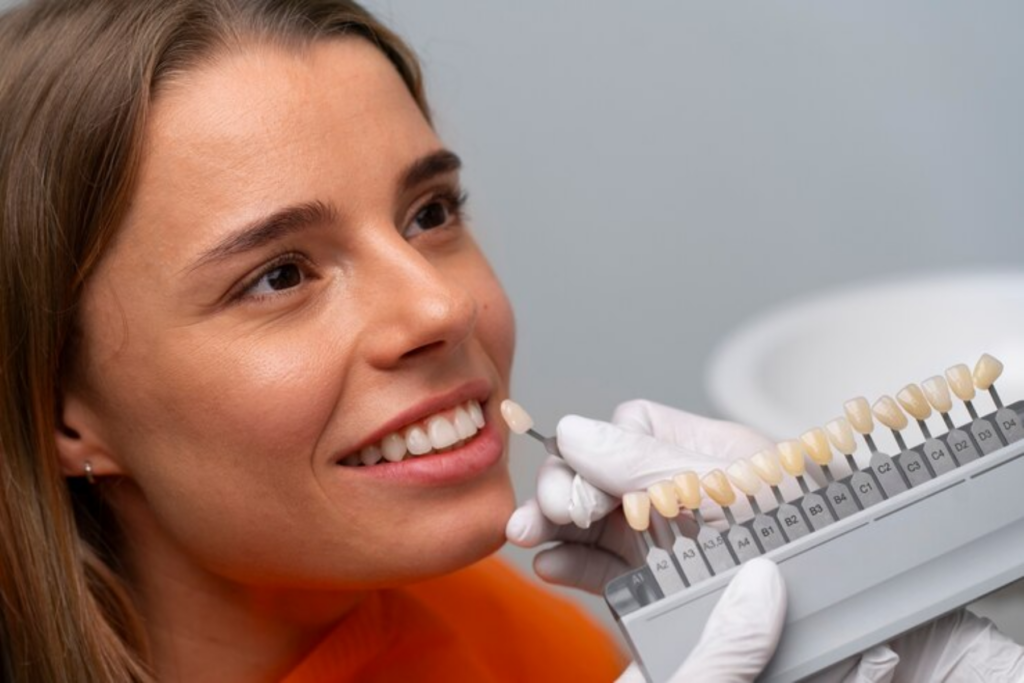How to Handle Major Pain After Dental Veneers: A Step-by-Step Approach

Dental veneers are a popular cosmetic dentistry option for achieving a beautiful smile. These thin shells of porcelain or composite resin are custom-made to cover the front surface of teeth, enhancing their appearance and correcting imperfections. While the procedure is generally safe and effective, some patients may experience discomfort or pain after getting veneers. In this guide, we’ll discuss how to handle major pain after dental veneers, offering a step-by-step approach to alleviate discomfort and promote healing.
Understanding Dental Veneers:
Before delving into pain management strategies, it’s essential to understand what dental veneers are and how they work. Veneers are designed to address various cosmetic concerns, including:
- Discoloration: Veneers can cover stained or discolored teeth, restoring a bright, white smile.
- Chipped or cracked teeth: Veneers can conceal minor dental damage, improving the appearance of teeth.
- Gaps between teeth: Veneers can close gaps and create a more uniform smile.
- Misaligned teeth: Veneers can provide a straighter appearance without the need for orthodontic treatment.
The veneer placement process typically involves several steps, including consultation, tooth preparation, impression taking, veneer fabrication, and bonding. While the procedure is minimally invasive compared to other dental treatments, some discomfort during the recovery period is normal.

Step-by-Step Approach to Handling Major Pain After Dental Veneers:
1. Communicate with Your Dentist:
If you’re experiencing significant pain after getting dental veneers, don’t hesitate to contact your dentist. Effective communication is key to addressing any concerns or complications promptly. Your dentist can evaluate your symptoms, determine the underlying cause of your pain, and recommend appropriate treatment options.
2. Take Over-the-counter Pain Medication:
For mild to moderate discomfort, over-the-counter pain relievers such as ibuprofen or acetaminophen can provide temporary relief. Follow the dosage instructions provided on the medication packaging and avoid exceeding the recommended dose.
3. Use Cold Compresses:
Applying a cold compress to the affected area can help reduce inflammation and numb the surrounding tissues, alleviating pain. Wrap a few ice cubes in a clean cloth or towel and hold it against your cheek for 10-15 minutes at a time. Be sure to take breaks between applications to prevent skin irritation.
4. Avoid Hard or Chewy Foods:
To prevent further irritation or damage to your veneers, avoid consuming hard, crunchy, or chewy foods that require excessive biting or chewing force. Stick to soft, easy-to-chew foods such as yogurt, mashed potatoes, soup, and smoothies until your pain subsides.
5. Practice Good Oral Hygiene:
Maintaining good oral hygiene is essential for promoting healing and preventing complications after getting dental veneers. Continue to brush and floss your teeth regularly, being gentle around the gumline and avoiding excessive pressure on the veneered teeth.
6. Rinse with Salt Water:
Saltwater rinses can help reduce pain and inflammation while promoting oral hygiene. Mix a teaspoon of salt into a glass of warm water and swish it around your mouth for 30-60 seconds before spitting it out. Repeat this process several times a day as needed.
7. Follow Post-Procedure Instructions:
Your dentist will provide you with specific post-procedure instructions to follow after getting dental veneers. These instructions may include avoiding certain activities, using prescribed medications, and attending follow-up appointments. Adhering to these guidelines can help ensure a smooth recovery process and minimize complications.
8. Give It Time:
It’s normal to experience some discomfort or sensitivity after getting dental veneers, especially in the days immediately following the procedure. However, most pain and discomfort should gradually improve within a week or two as your mouth adjusts to the new veneers. If your symptoms persist or worsen over time, be sure to consult your dentist for further evaluation.
While dental veneers can enhance your smile and boost your confidence, it’s essential to be prepared for the possibility of experiencing pain or discomfort during the recovery process. By following these step-by-step strategies for handling major pain after dental veneers, you can alleviate discomfort, promote healing, and enjoy the long-lasting benefits of your new smile. Remember to communicate openly with your dentist, follow post-procedure instructions diligently, and give yourself time to heal properly. Your smile deserves the best care possible, so don’t hesitate to seek professional help if you have any concerns or questions along the way.


